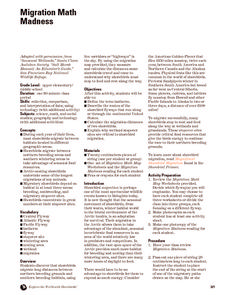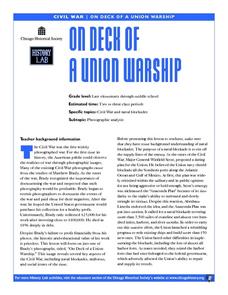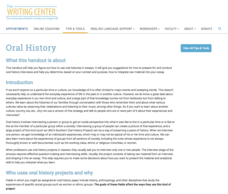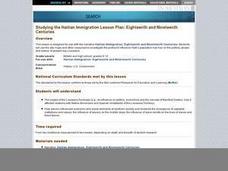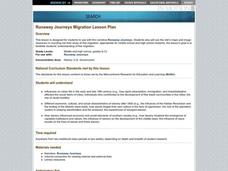Prince William Network
Migration Math Madness
A great way to incorporate math into life science, this lesson has learners measure migratory routes on a map and calculate the actual distance that shorebirds on the routes would cover. Learners compute the distance covered in both...
North Carolina Consortium for Middle East Studies
Missing Pieces of the Puzzle: African Americans in Revolutionary Times
What's missing from most studies of the American Revolutionary War is information about the role African Americans played in the conflict. To correct this oversight, middle schoolers research groups like the Black Loyalists and Black...
Curated OER
Stone Tools of Texas Indians
Provide background information regarding the use of stone tools from the paleoindian through the late prehistoric periods. Learners can read this informational passage to gain insight on how and why we study these amazing artifacts from...
Curated OER
The True Cost of Coffee
Young scholars examine the economic, health and environmental risks of being a one-crop country. They explain the risks of relying on one crop. They also identify the factors that resist change.
Curated OER
On Deck of a Union Warship
Students examine role of Naval blockades in Union war strategy, and analyze primary source image "On Deck of a Union Warship" and make detailed observation about people and activities shown.
Curated OER
The Pre-Civil War Era (1815–1850)
In this online interactive U.S. history worksheet, students respond to 9 short answer and essay questions about 19th century America. Students may check some of their answers on the interactive worksheet.
Curated OER
Immigration in Spain
How many people immigrate to Spain illegally each year? Both the United States and Spain see a lot of illegal immigration. Advanced learners will read various articles, compare and contrast the situation in both countries, and discuss...
Curated OER
Civil War Sites and Battlefields in Arkansas
Modern day and historic images grace an informative presentation. Learners can review multiple battles and effects of the Civil War on the state of Arkansas. Major sites and battle fields are shown as they looked in the past and as they...
K12 Reader
Glossary of Non-Violence
Make sure your class is sure of terminology when referring to the non-violent methods used in the civil rights movement. This glossary includes 19 terms paired with parts of speech and definitions.
Tennessee State Museum
An Emancipation Proclamation Map Lesson
Did the Emancipation Proclamation free all slaves during the Civil War? Why was it written, and what were its immediate and long-term effects? After reading primary source materials, constructing political maps representing information...
Curated OER
Feudal Powers in Japan
A traditional textbook chapter focuses on feudal powers in Japan, and includes vocabulary, note-taking tips in the sidebar, main ideas, and follow-up assessment questions. It also incorporates opportunities for art analysis and geography...
American Chemical Society
Norbert Rillieux, Thermodynamics and Chemical Engineering
The man who invented the earliest examples of chemical engineering was an American-born, French-educated, free man of color before the Civil War, and went on to translate Egyptian hieroglyphics. There is something of interest for almost...
Constitutional Rights Foundation
Ellis Island—The “Golden Door” to America
Are you one of the 100 million Americans whose ancestors passed through the doors of Ellis Island? Learn about the historic entry point for immigrants in the late 19th and early 20th centuries with an informative reading passage. After...
Teaching for Change
A Documents-Based Lesson on the Voting Rights Act
How did the Voting Rights Act affect the daily lives of American citizens? A document-based lesson developed by the Student Non-Violent Coordinating committee (SNCC) presents a case study of the impact of the Voting Rights Act of 1965 on...
University of North Carolina
Oral History
There's no better way to learn something than to hear it straight from the horse's mouth. A handout on oral history, part of a larger series on specific writing assignments, explains how to conduct interviews and use the information...
Curated OER
Making Democracy Work for Everyone, 1877-1904
Young scholars investigate the culture of the post Reconstruction South. They participate in a jigsaw research activity, conduct Internet research on an assigned topic, and write a report to present to the class.
Curated OER
Political and Social Origins of the Civil War
Students examine the difference in politics in the North and South during the Civil War. Using that information, they discuss how politics and ideologies led to the war. They explain the causes and effects of the war and evaluate the...
Curated OER
Why Was It Difficult To "reconstruct the South"?
Students examine problems faced by the states of the Confederacy following the Civil war. They predict how Lincoln wanted to handle the problem of reconstruction by listening to his words. They describe conditions in the South...
Curated OER
Studying the Haitian Immigration: 18th and 19th centuries
Students read a narrative and conduct extensive research to determine how Haiti's population has had an influence on the social, political, and economic culture of present-day Louisiana. As a culminating activity, students write papers...
Curated OER
THE GREAT DISMAL SWAMP
Learners analyze how slavery shaped social and economic life in the South after 1800, the different economic, cultural, and social characteristics of slavery after 1800, and slavery both prior and after the Civil War.
Curated OER
MANY REASONS TO LEAVE
Students research different economic, cultural, and social characteristics of slavery after 1800, how slavery hindered the emergence of capitalist institutions and values, and slavery both prior to and after the Civil War.
Curated OER
RUNAWAY JOURNEYS MIGRATION
Students analyze the influences on urban life in the early and late 19th century, different economic, cultural, and social characteristics of slavery after 1800, the rise of racial hostility, and the ending of the Atlantic slave trade.
Curated OER
Unsung Military Heroes
In this lesson, students are introduced to the contributions made by African-American soldiers that have been excluded from traditional textbooks. To gain an appreciation for these unsung heroes, students engage in research to ultimately...
Curated OER
Heaven, Hell, and Baltimore
This lesson allows pupils to research and compare the city of Baltimore to other northern cities of interest during the Great Migration. After reading a narrative entitled Return South Migration and conducting extensive research,...


